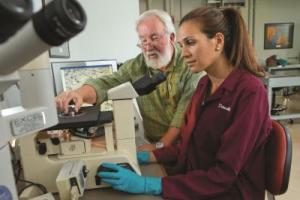Mar 7 2014
Worcester Polytechnic Institute (WPI) is the lead institution on a $7.4 million, multi-university award from the U.S. Army that will support the development of new metallurgical methods and new lightweight alloys that will help the military build more effective and durable vehicles and systems. The technologies and processes developed as part of the research will also have applications in the aircraft, automotive, and electronics industries.
 Richard Sisson, George F. Fuller Professor of Mechanical Engineering at Worcester Polytechnic Institute (WPI), and postdoctoral student Danielle Belsito examine a sample of an aluminum alloy under a light microscope in WPI's materials testing laboratory. (Credit: Worcester Polytechnic Institute/Patrick O'Connor)
Richard Sisson, George F. Fuller Professor of Mechanical Engineering at Worcester Polytechnic Institute (WPI), and postdoctoral student Danielle Belsito examine a sample of an aluminum alloy under a light microscope in WPI's materials testing laboratory. (Credit: Worcester Polytechnic Institute/Patrick O'Connor)
WPI will receive $2.1 million through the two-year award, which is the latest installment from a multi-year cooperative agreement with the Army that previously brought more than $4 million in research funding to the university. The overall aim of the research is the development of databases and computer modeling techniques that will make it possible to predict the nanoscale properties of lightweight alloys (primarily aluminum, titanium, and magnesium), and to use these computational tools to design and test new alloys for specific military applications.
"The military is looking to develop super-materials that can meet several needs at once," said Richard Sisson, George F. Fuller Professor of Mechanical Engineering, director of WPI's Materials Science and Engineering Program, and principal investigator for the Army award. "They want new alloys that are strong enough to be used structurally, tough enough to function as armor, and light enough to improve the mobility and fuel economy of vehicles."
Through an approach dubbed "nanomaterials by design," Sisson and co-principal investigators Diran Apelian, Alcoa-Howmet Professor of Mechanical Engineering at WPI and director of the university's Metal Processing Institute (MPI), and Makhlouf Makhlouf, director the MPI's Aluminum Casting Research Center, are using a variety of modeling techniques, including thermodynamic models and kinetic models, in concert with laboratory studies, to predict the microstructure and microchemistry of new alloys. To a large degree, the microstructure determines how the alloy will perform.
The researchers are also studying a variety of metallurgical processes, including heat treating, which can alter an alloy's microstructure. From this work they are deriving modelling tools that can be used to improve existing alloys or custom design new alloys with desired properties.
Part of the work focuses on a process called cold spray, in which metal powders are accelerated to transonic speeds. When the high-speed spray is aimed at metal parts, the power particles fuse with the existing metal, making the technique an effective way to repair cracks or to add a protective coating. Military applications, like repairing aircraft and helicopter engine components, require high strength, toughness, and ductility. WPI postdoctoral student Danielle Belsito has already developed tools that can accurately predict the properties of the powder particles, making it possible to develop new alloys that, when cold sprayed, meet these requirements.
The new award also includes a focus on high-strength magnesium alloys used by the military, particularly in aircraft components. Currently used alloys contain rare earth elements (REEs) that are expensive and increasingly difficult to obtain, as most come from China, which is restricting exports of REEs to meet the needs of its own military and commercial uses (the materials are used in such applications as batteries, wind turbines, cell phones and other electronics, and guided missile systems). WPI will develop new magnesium alloys that require fewer REEs, or which use more readily available REEs. It will also explore methods for extracting REEs from ores found outside of China and for recovering REEs from recycled metals.
The latter research will be led by co-principal investigators Jianyu Liang, associate professor of mechanical engineering, Yan Wang, assistant professor of mechanical engineering, and Marion Emmert, assistant professor of chemistry and biochemistry. In related work, the researchers are also engaged in research on metal recovery and recycling through WPI's Center for Resource Recovery and Recycling, a National Science Foundation Industry and University Cooperative Research Program that focuses on the sustainable reuse of materials.
"The work with magnesium alloys fits well with our evolving expertise with the modelling and design of high-strength, lightweight alloys, but allows us to bring in new expertise on extractive metallurgical chemistry and materials recovery to address a problem of vital concern to the U.S. military," Sisson says.